Llanfachreth is a settlement around three miles north-east of Dolgellau, in the ancient county of Merionethshire. The village is on the slopes of the valley of the river Mawddach and at the foot of Foel Offrwm and Rhobell Fawr. The men of the village who fell during the Great War are commemorated on a war memorial in the form of a Celtic Cross, which is situated on a road junction at the village centre, in front of the church.
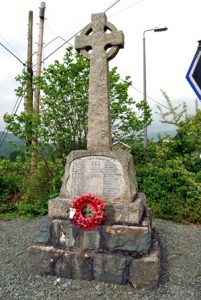
The Great War, 1914-1918
David John Davies, Private, 291274, Royal Welsh Fusiliers. David was the son of David and Anne Davies, of Brynteg, Llanfachreth. He lived at Tyddynmawr, Islawrdref, Dolgellau prior to the war. David enlisted at Dolgellau into the 3/7th Battalion, Royal Welsh Fusiliers on 23 November 1915, and was posted to Park Hall, Oswestry for training. On 29 May 1916 David was posted to Egypt to join the 1/7th Battalion, Royal Welsh Fusiliers, which was attached to 158 Brigade, 53rd (Welsh) Division. The Division was attached to the EEF, guarding the Suez Canal, and was preparing to launch an offensive into Palestine on 26 March 1917. David was wounded in the head and taken prisoner by the Turks at the First Battle of Gaza on 26 March 1917. He was reported to have written to his parents a letter dated 3 April 1917, and was then reported to have died in hospital in Gaza on 19 April 1917 of his wounds. Further investigations by the War Office could not be positive of this report, but David was later adjudged to have died at some time between 3 April and 3 October 1917. The official date of his death is therefore recorded as the latter, 3 October 1917, but the Turkish report stating 19 April is most probably correct. David was 21 years old, and is commemorated on the Jerusalem Memorial, Israel.
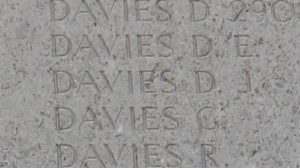
James Griffith, Private, 3900, Royal Welsh Fusiliers. James was the son of Morris and Margaret Griffith, of Ochyryfoel Ucha, Llanfachreth. He worked as a farm labourer prior to enlisting at Dolgellau into the 3/7th Battalion, Royal Welsh Fusiliers soon after the outbreak of war. James was posted to Park Hall, Oswestry for training, but soon took ill, and was sent to Chester Isolation Hospital. He died there on 27 February 1916, aged 17. His remains were brought home for burial in St. Machreth Churchyard, Llanfachreth.
David Jones, Private, 25546, Royal Welsh Fusiliers. David was the son of Edward and Margaret Jones, of Penrhos Isaf, Llanfachreth. He worked as a labourer prior to enlisting at Bala into the 17th Battalion, Royal Welsh Fusiliers on 27 February 1915. He was posted to Llandudno where the battalion was training as part of the newly formed 128 Brigade, 43rd (Welsh) Division. On 29 April 1915 the formation became 113 Brigade, 38th (Welsh) Division, and moved to Winchester to complete its training before moving to France on 4 December 1915. The Division then moved to the Nursery Sector near Fleurbaix for trench initiation alongside the Guards Division. The Division then took over a section of line near Cuinchy, in terrible conditions, where it remained over the coming months. By 23 June 1916 the conditions had taken their toll on David’s health, and he was admitted to the 130th Field Ambulance suffering from bronchitis. He was posted to Rouen, where he became ill again and was treated in hospital in Le Treport. Upon his recovery, he was posted to the 2nd Battalion, Royal Welsh Fusiliers, reaching the battalion on the Somme on 27 July 1916, where it was attached to 19 Brigade, 33rd Division. The Division fought throughout the Somme offensive, and by the beginning of November 1916 was in the line near Lesboeufs. Over the coming days the battalion carried out a number of raids and made an assault in support of a French attack, in dire conditions, and on the night of 7 November was relieved, marching back to La Briqueterie, then to Meaulte, where the Prince of Wales visited. David was found to be missing during the battalion roll call here, and was later found to have been captured by the Germans in the last torrid spell in the line. He was taken to a camp near Cambrai, but his health again broke down and he died at the Cambrai POW Hospital on 7 February 1917, aged 21. David was originally buried in Hendecourt-les-Cagnicourt, but the graves there were lost during fighting later in the war, so he is now commemorated on a Special Memorial within Croisilles British Cemetery, France.
Griffith Thomas Jones, Private, 22916, Grenadier Guards. Griffith was the son of William and Sydney Jones. The family had moved to Cwmheisian, Llanfachreth by 1908. Griffith enlisted at Ruabon into the Grenadier Guards soon after the outbreak of war, and was posted to France on 6 November 1915, joining the 1st Battalion, Grenadier Guards, which was near Lapugnoy attached to the 3rd Guards Brigade, Guards Division. He spent the winter with the battalion in Flanders, then in July 1916 the Guards Division moved south to take part in the Somme offensive. Griffith had taken ill at some time before the move to the Somme, and was invalided back to Britain. He died of tuberculosis at Epsom Military Hospital, Surrey on 3 December 1916, aged 22. His remains were brought back to Wales and he was buried in St. Michael’s Churchyard, Llanfihangel-Y-Traethau.
John Charles Jones, Private, 291291, Royal Welsh Fusiliers. John was born in Churchstoke, Montgomery, the son of Charles and Minnie Jones. By 1914 the family had moved to Hengar Cottage, Llanfachreth Road, Dolgellau. He enlisted at Welshpool into the 7th Battalion, Royal Welsh Fusiliers soon after the outbreak of war. The battalion was a Territorial unit, which mobilised for war at Newtown in August 1914, as part of North Wales Brigade, Welsh Division and moved to Conway until the end of the month, before moving to Northampton. In December the Division moved to Cambridge and then in May 1915 to Bedford, where the Division was numbered and the formation became 158 Brigade, 53rd (Welsh) Division. On 19 July 1915 the entire Division sailed from Devonport for Imbros and on 9 August 1915 landed at Suvla Bay. John joined up with the battalion in Egypt, following its evacuation from Gallipoli in December 1915. The Division had moved to Egypt to join the EEF, and helped guard the Suez Canal before taking part in operations to drive the Turks out of the Sinai. The EEF then turned its attention onto driving the Turks out of Palestine, and on 26 March 1917 launched its first offensive against the coastal city of Gaza, which guarded the road to Jerusalem. Initial gains during the day were lost when the assaulting divisions lost touch with each other and communication broke down when a thick fog cloaked the battlefield. John was killed in action during the days fighting. The 21-year-old has no known grave and is commemorated on the Jerusalem Memorial, Israel. His brother, Joseph, died the following year.
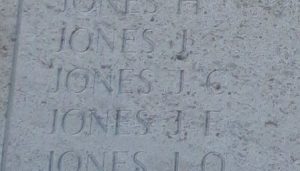
Joseph Robert Jones, Shoeing Smith, 604284, Royal Horse Artillery. Joseph was born in Liverpool on 7 August 1895, the son of Charles and Minnie Jones. By 1914 the family had moved to Hengar Cottage, Llanfachreth Road, Dolgellau. Joseph served with the 2/1st (Shropshire) Brigade, Royal Horse Artillery, on home service, during the war. He was discharged as medically unfit in the summer of 1918 and died at home on 23 August 1918, aged 23. He is buried in St. Machraeth Churchyard, Llanfachreth. His brother, John, had been killed at Gaza the previous year.
Owen Jones, Private, 2738, Welsh Guards. Owen was the son of John and Gwen Jones, of Ochryfoel Ucha, Llanfachreth. He enlisted at Dolgellau into the Welsh Guards and after completing his training, was posted to France, joining the 1st Battalion, Welsh Guards, which was attached to the Guards Division. He probably joined the battalion in the autumn of 1916, following its efforts during the Somme offensive that summer. Following the Battle of Morval, the Guards wintered on the Somme, and followed the German withdrawal to the Hindenburg Line the following year. The Division then went into a rest area at Péronne, then to St. Omer at the end of May 1917, where the Guards Division trained in readiness for the forthcoming Passchendaele offensive. The Guards Division moved into the line north of Pilckem, to the left of the 38th (Welsh) Division, and prepared for the offensive, which would be launched on 31 July. Less than two weeks prior to the offensive, the Welsh Guards was in the process of being relieved from a tour in the front line on 19 July 1917, when the battalion came under heavy German artillery fire. Owen was killed in the bombardment. He was 26 years old and is buried in Canada Farm Cemetery, Belgium.
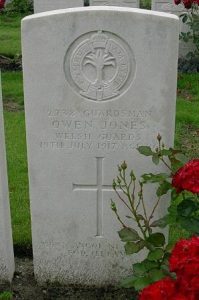
Robert Griffith Jones, Gunner, 77104, Royal Garrison Artillery. Robert was the son of Catherine Jones, of Tanygaer, Llanfachreth. He worked as a driver prior to the war. Robert enlisted at Dolgellau into the Royal Garrison Artillery on 14 February 1916, and was posted to Fort Brockhurst, Gosport, for training, before being posted to Pembroke Dock on 12 May. He was posted out to France to join the 216th Siege Battery, Royal Garrison Artillery on 22 September 1917. The battery was in the Loos sector where it had suffered a number of casualties whilst supporting the Battle of Hill 70. Robert served with the battery for just three months before he was taken prisoner by the Germans on 30 November 1917, and was reportedly taken to Munster II Camp. He became ill whilst in captivity, and died of pulmonary catarrh at the War Hospital at Condé on 29 June 1918, aged 39. He was buried with full military honours in Conde-Sur-L’Escaut Communal Cemetery, France.
Robert Morris Jones, Gunner, 92059, Royal Garrison Artillery. Robert was born on 9 August 1893, the son of Robert and Jane Jones, of Llanfachreth. He worked as an engineer for the Great Western Railway prior to the war, and was living at Sale. Robert married Jane Ellen Evans at Ashton-on-Mersey on 26 June 1915. He enlisted at Sale into the Royal Garrison Artillery on 10 December 1915, and was posted to Fort Brockhurst, Gosport for training. Robert was found to be unfit for overseas service and was posted to the 558th Agricultural Company, Labour Corps on 17 December 1917. He survived the war but contracted influenza and died of broncho pneumonia on 3 February 1919, aged 26. Robert is buried in St. Machraeth Churchyard, Llanfachreth.
Joseph Kynaston, Private, 9144, Royal Welsh Fusiliers. Joseph was the son of Mary Kynaston, of Nannau, Llanfachreth. He enlisted into the Royal Welsh Fusiliers Militia at Festiniog on 14 November 1904, and then enlisted at Wrexham into the 2nd Battalion, Royal Welsh Fusiliers on 7 July 1906, serving for several years at Quetta, India with the battalion. When war was declared the battalion was at Portland and on 11 August 1914 landed at Rouen as Line of Communications Troops. On 22 August 1914 the battalion joined 19 Brigade, at Valenciennes, and two months later, on 12 October 1914, the Brigade joined the 6th Division at Strazeele. Over the coming days the Division marched through Bailleul for Vlamertinghe, and on 20 October moved again to Laventie, before the 2nd RWF took over the line at La Boutillerie and La Cordonnerie Farm. Joseph was one of two men of the battalion killed by snipers in the line here on 23 October 1914. He was 30 years old, and is buried in Pont-du-Hem Military Cemetery, La Gorgue, France.
John Aneurin Owen, Private, 54612, Machine Gun Corps. John was the son of Owen Edward Owen and Jane Owen, of Tycerrig, Llanfachreth. He enlisted at Holywell into the Royal Welsh Fusiliers, and after completing his training was posted to France, joining the 47th Battalion, Machine Gun Corps. The battalion was attached to the 47th Division, and was formed in February 1918, whilst the Division was in the St. Quentin area. The Division faced the German Spring Offensive here on 21 March, and took part in an epic rear-guard action during the coming days. The fighting calmed down in this area over the coming months, after the Germans switched their attentions elsewhere. John was wounded whilst the Division was still in the area, and died of his wounds on 1 August 1918, aged 22. He is buried in Warloy-Baillon Communal Cemetery Extension, France.
William Robert Owen, Private, 291073, Royal Welsh Fusiliers. William was the illegitimate son of Elizabeth Owen, of Dyffryn, Barmouth. He was raised by his Aunt, Mrs Susannah Jones, at Trawsfynydd, before re-joining his mother at some time prior to 1911, as they were living as tenants at Caemawr, Ganllwyd. He enlisted at Dolgellau on 23 April 1915 into the 2/7th Battalion, Royal Welsh Fusiliers and was posted to Northampton with the battalion. On 26 June 1915 William was transferred to the 1/7th Battalion, Royal Welsh Fusiliers. The battalion was a Territorial unit, which mobilised for war at Newtown in August 1914, as part of North Wales Brigade, Welsh Division and moved to Conway until the end of the month, before moving to Northampton. In December the Division moved to Cambridge and then in May 1915 to Bedford, where the Division was numbered and the formation became 158 Brigade, 53rd (Welsh) Division. On 19 July 1915 the entire Division sailed from Devonport for Imbros and on 9 August 1915 landed at Suvla Bay. The Division was eventually evacuated from Gallipoli in December 1915, moving to Egypt to join the EEF, and helped guard the Suez Canal before taking part in operations to drive the Turks out of the Sinai. The EEF then turned its attention onto driving the Turks out of Palestine, and on 26 March 1917 launched its first offensive against the coastal city of Gaza, which guarded the road to Jerusalem. The battle was a failure for the EEF, and a second assault on Gaza was launched on 17 April which also failed, resulting into the Commander of the EEF being replaced by Sir Edmund Allenby. He reorganised the EEF before launching a third offensive on a wider front, from Beersheba to Gaza, on 6 November 1917, which broke the Turkish lines. William was killed in action that day, during the Third Battle of Gaza. The 22-year-old is buried in Beersheba War Cemetery, Israel.
Arthur Griffith Price, Private, 1711, Welsh Guards. Arthur was the of Griffith and Laura Price, of Corsygarnedd, Llanfachreth. He enlisted into the Royal Welsh Fusiliers soon after the outbreak of war, but then volunteered for the Welsh Guards. He was posted to France early in 1916 to join the 1st Battalion, Welsh Guards, which was attached to the Guards Division and joined the battalion at La Gorgue. On 17 February the Welsh Guards moved to the Calais area to rest and spent St. David’s Day at Wormhoudt. By 17 March the Guards Division had moved into the Ypres sector, to begin a tour of duty in the Salient. Arthur was badly wounded when the Welsh Guards were holding the line neat Potijze on 4 April, and died of his wounds two days later, on 6 April 1916, aged 18. He is buried in Lijssenthoek Military Cemetery, Belgium.
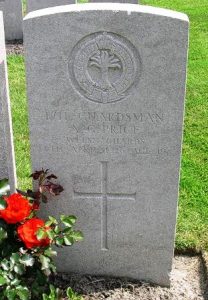
Robert Owen Thomas, Lance Corporal, 20915, Royal Welsh Fusiliers. Robert was the son of John and Sarah Thomas, of Glasgoed, Llanfachreth. He worked as a tramway conductor at Liverpool prior to the war. Robert enlisted in Liverpool into the 14th Battalion, Royal Welsh Fusiliers. The battalion was raised at Llandudno by the Welsh National Executive Committee as part of 128 Brigade, 43rd (Welsh) Division, then on 29 April 1915 the formation became 113 Brigade, 38th (Welsh) Division. In August 1915 the Division moved to Winchester to complete its training and on 2 December 1915 moved to France, being sent to the Nursery Sector near Fleurbaix for trench initiation. The Division then held a sector of the line near Cuinchy before marching south to the Somme sector in June 1916 to take part in the assault on Mametz Wood. At some time afterwards Robert was transferred to the 9th Battalion, Royal Welsh Fusiliers, which was attached to 58 Brigade, 19th (Western) Division. The Division had seen heavy fighting on the Somme in 1916, and in 1917 fought at Messines Ridge and at Ypres, before moving to the Somme sector in 1918. When the Germans launched their Spring Offensive on 21 March 1918, the 19th Division was caught up in desperate fighting. It was then moved north to Messines again and was hit here by the second phase of the German offensive, which was launched on the Lys on 9 April. Again, the Division suffered terrible casualties, and was moved to the Aisne to rest. Unfortunately, the third phase of the German offensive was launched here on 27 May and the Division again became caught up in heavy fighting. Robert was taken prisoner here on 30 May 1918 and was taken to a POW camp in Kassel, Germany. He died of disease in captivity on 29 August 1918, aged 28, and is buried in Niederzwehren Cemetery, Kassel, Germany.
Evan Robert Williams, Private, 49699, Royal Welsh Fusiliers. Evan was the son of Evan and Margaret Williams, of Werngoch, Bala. He lived at Abergeirw, Llanfachreth prior to enlisting at Dolgellau into the 7th Battalion, Royal Welsh Fusiliers. The battalion was a Territorial unit, which mobilised for war at Newtown in August 1914, as part of North Wales Brigade, Welsh Division and moved to Conway until the end of the month, before moving to Northampton. In December the Division moved to Cambridge and then in May 1915 to Bedford, where the Division was numbered and the formation became 158 Brigade, 53rd (Welsh) Division. On 19 July 1915 the entire Division sailed from Devonport for Imbros and on 9 August 1915 landed at Suvla Bay. The Division was evacuated from Gallipoli in December 1915, moving to Egypt to join the EEF, and helped guard the Suez Canal before taking part in operations to drive the Turks out of the Sinai. The EEF then turned its attention onto driving the Turks out of Palestine, and on 26 March 1917 launched its first offensive against the coastal city of Gaza, which guarded the road to Jerusalem. At some time after this, Evan was transferred to the 2nd (Garrison) Battalion, Royal Welsh Fusiliers, which was on garrison duty in Egypt. He survived the war, but died of pneumonia in hospital in Alexandria on 12 January 1919, aged 26. Evan is buried in Alexandria (Hadra) War Memorial Cemetery, Egypt.